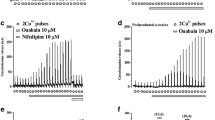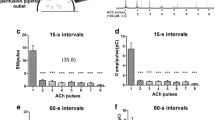Abstract
Measurements of intracellular Ca2+ in adrenal medullary cells suggest that a transient rise in Ca2+ leads to a transient secretory response, the rise in Ca2+ being brought about by an influx through voltage-sensitive Ca channels which subsequently inactivate. The level of Ca2+ observed is much smaller than the Ca2+ needed to trigger secretion when introduced directly into the cell. The discrepancy is removed by the presence of diacylglycerot, which increases the sensitivity of the secretory process to Ca2+. The site of action of Ca2+ and diacylglycerol is probably protein kinase C, and tile different secretory responses to increases of Ca2+ and diacylglycerol can be modelled in terms of a preferential order of binding of these two substrates to the enzyme. ATP is needed for secretion: one role is possibly to confer stability to the secretory apparatus; another may involve phosphorylation of some key protein. The kinetics of secretion suggest that if Ca2+ regulates phosphorylation or dephosphorylation, then it is therate of change of phosphorylation that controls secretion rather than theextent of phosphorylation or dephosphorylation. Guanine nucleotide-binding proteins may play a role not only at the level of signal transduction coupling, but also at or near the site of exocytosis, and the mechanism by which some Botulinum toxins inhibit secretion may be associated with these proteins.
Similar content being viewed by others
References
Adam-Vizi, V. and Knight, D. E. (1987).J. Physiol. Lond. Proceedings (in press).
Artalejo, C. R., Bader, M. F., Aunis, D. and Garcia, A. G. (1986).Biochem. Biophys. Res. Comm. 134:1–7.
Baker, P. F. (1986).Progress in Zoology 33:265–274.
Baker, P. F., and Knight, D. E. (1978).Nature 276:620–622.
Baker, P. F. and Knight, D. E. (1981).Phil. Trans. Roy. Soc. Lond. B. 296:83–103.
Baker, P. F. and Knight, D. E. (1986).Brit. Med. Bulletin. 42:399–404.
Baker, P. F., Meeves, H. and Ridgway, E. B. (1973).J. Physiol. Lond. 231:527–548.
Baker, P. F. and Rink, T. J. (1975).J. Physiol. Lond. 253:593–620.
Barrowman, M. M., Cockcroft, S. and Gomperts, B. D. (1986).Nature (Lond.) 319:504–507.
Cobbold, P. E., Cheek, T. R., Cuthbertson, K. S. and Burgoyne, R. D. (1987).FEBS Lett. 211:44–48.
Cockcroft, S. and Gomperts, B. D. (1985).Nature 314:534–536.
Douglas, W. W. (1968).Brit. J. Pharmacol. 34:451–474.
Fenwick, E. M., Marty, A. and Neher, E. (1982).J. Physiol. Lond. 331:599–635.
Fernandez, J., Neher, E. and Gomperts, B. (1984).Nature 312:453–455.
von Grafenstein, H., Roberts, C. S. and Baker, P. F. (1986).J. Cell. Biol. 103: 2343–2352.
Gomperts, B. D. and Fernandez, J. M. (1985).Trends Biochem. Sci. 10:414–417.
Grynkiewicz, G., Poenie, M. and Tsien, R. Y. (1985).J. Biol. Chem. 260:3440–3450.
Haslam, R. J. and Davidson, M. M. L. (1984a).J. Rec. Res. 4:605–629.
Haslam, R. J. and Davidson, M. M. L. (1984b).FEBS Lett. 174:90–95.
Hess, P., Lansman, J. B. and Tsien, R. W. (1984).Nature 311:538–544.
Katz, B. (1969).The Release of Neuronal Transmitter Substances. Liverpool University Press, Liverpool.
Knight, D. E. (1986).FEBS Lett. 207:222–226.
Knight, D. E. and Baker, P. F. (1982).J. Memb. Biol. 68:107–140.
Knight, D. E. and Baker, P. F. (1983).FEBS Lett. 160:98–110.
Knight, D. E. and Baker, P. F. (1985a).FEBS Lett. 189:345–349.
Knight, D. E. and Baker, P. F. (1985b).J. Memb. Biol. 83:147–156.
Knight, D. E. and Kesteven, N. T. (1983).Proc. Roy. Soc. Lond. B. 218:177–199.
Knight, D. E. and Scrutton, M. C. (1984).Biochem. Trans. 12:969–972.
Knight, D. E. and Scrutton, M. C. (1986a).Biochem. J. 234:497–506.
Knight, D. E. and Scrutton, M. C. (1986b).Europ. J. Biochem. 160:183–190.
Knight, D. E. and Scrutton, M. C. (1987).FEBS Lett. (in press).
Knight, D. E., Hallam, T. J. and Scrutton, M. C. (1982).Nature Lond. 296:256–257.
Knight, D. E., Niggli, V. and Scrutton, M. C. (1984).Europ. J. Biochem. 143:437–446.
Knight, D. E., Tonge, D. A. and Baker, P. F. (1985).Nature Lond. 317:719–721.
Knopf, J. L., Leu, M. H., Sultzman, L. A., Kriz, R. W., Loomis, C. R., Hewick, R. M. and Bell, R. M. (1986).Cell 40:491–502.
Linas, R., McGuiness, T., Leonard, D., Sugimori, M. and Greengard, P. (1985).Proc. Nat. Acad. Sci. 83:3035–3039.
Llinas, R. J., Blinks, R. and Nicholson, C. (1972).Science 176:1127–1129.
Lumpert, C. J., Kersken, H., Gras, U. and Plattner, H. (1987).Cell Biol. Int. Rep. 11:405–414.
Navonne, F., Greengard, P. and DeCamillo, P. (1984).Science 226:1209–1211.
Niggli, V., Knight, D. E., Baker, P. F., Vigny, A. and Henry, J.-P. (1984).J. Neurochem. 43:646–658.
Nishizuka, Y. (1984).Nature,308:693–698.
Nowycky, M. C., Fox, A. P. and Tsien, R. W. (1985)Nature 316:440–443.
Oetting, M., LeBoff, M., Swiston, L., Preston, J. and Brown, E. (1986).FEBS Lett. 208:99–104.
Ohashi, Y. and Narumiya, S. (1987).J. Biol. Chem. 262:1430–1433.
Penner, R., Neher, E. and Dreyer, F. (1986).Nature 324:76–78.
Phillips, J. H., Burridge, K. E., Wilson, S. P. and Kirshner, N. (1983).J. Cell. Biol. 97:1906–1917.
Pozzan, T., Gatti, G., Dozio, N., Vicentini, L. M. and Meldolesi, J. (1984).J. Cell. Biol. 99:628–638.
Reuter, H. (1983).Nature 301:569–574.
Rink, T. J. and Hallam, T. J. (1984).TIBS 12:215–219.
Rink, T. J., Sanchez, A. and Hallam, T. J. (1983).Nature 305:317–319.
Salama, G., Johnson, R. G. and Scarpa, A. (1980).J. Gen. Physiol. 75:109–140.
Shoback, D., Thatcher, J., Leombruno, R. and Brow, E. (1984).Proc. Nat. Acad. Sci. 81:3113–3117.
Tsien, R. Y. (1981).Nature 290:527–528.
Tanaka, T., Yokohama, H., Negishi, M., Hayashi, I., Ito, S. and Hayaishi, O. (1987).Biochem. Biophys. Res. Comm. 144:907–914.
Toutant, M., Aunis, D., Bockaert, J., Homburger, V., and Rouot, B. (1987).FEBS Lett. 215:339–344.
Vilmart-Seuwen, J., Kersken, H., Sturzl, R. and Plattner, H. (1986).J. Biol. Chem. 103:1279–1288.
DiVirgilio, F., Lew, D. and Pozzan, T. (1984).Nature 310:691–693.
Zeiseniss, E. and Plattner, M. (1985).J. Cell. Biol. 101:2028–2035.
Author information
Authors and Affiliations
Rights and permissions
About this article
Cite this article
Knight, D.E. Calcium and diacylglycerol control of secretion. Biosci Rep 7, 355–367 (1987). https://doi.org/10.1007/BF01362500
Received:
Issue Date:
DOI: https://doi.org/10.1007/BF01362500




